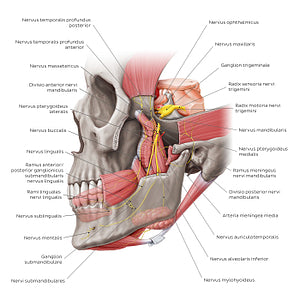Paul Kim
Mandibular nerve (Latin)
Mandibular nerve (Latin)
The divisio posterior nervi mandibularis is mainly sensory and is larger than the divisio anterior. The n. auriculotemporalis arises posterior to the articulatio temporomandibularis (usually as two roots which encircle the a. meningea media) and supplies parts of the auricula/meatus acusticus externus and posterior half of the regio temporalis. Sympathetic/parasympathetic fibers to the gl. parotidea (derived from the plexus of the a. meningea media and ggl. oticum, respectively) are also carried within this nerve. The n. lingualis arises from the bifurcation of the divisio posterior, and carries general somatic afferent/sensory fibers from the anterior two-thirds of the tongue (lingua), floor of the oral cavity and lower lingual gingiva. It is joined by the chorda tympani (of n. facialis) which delivers general visceral efferent/parasympathetic fibers to the gl. submandibularis/sublingualis via homonymous/same-named branches of the n. lingualis. Special visceral afferent/taste fibers from the anterior two-thirds of the tongue are carried by the n. lingualis to the chorda tympani. The n. alveolaris inferior is a mixed nerve, carrying sensory fibers from the mandibular teeth via the plexus dentalis inferior (see first image) and lower lip/labial gingiva (via n. mentalis), as well as general somatic afferent/motor fibers to the m. mylohyoideus and venter anterior musculi digastrici.
Normaler Preis
$7.56 USD
Normaler Preis
Verkaufspreis
$7.56 USD
Grundpreis
pro
Verfügbarkeit für Abholungen konnte nicht geladen werden


#DCB727
#9E5E54
#69221E
#4F3845
#F0DF5A und #CEB0AB

